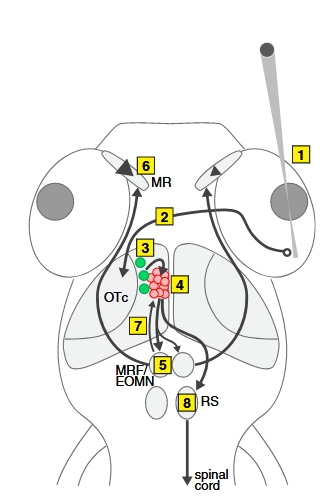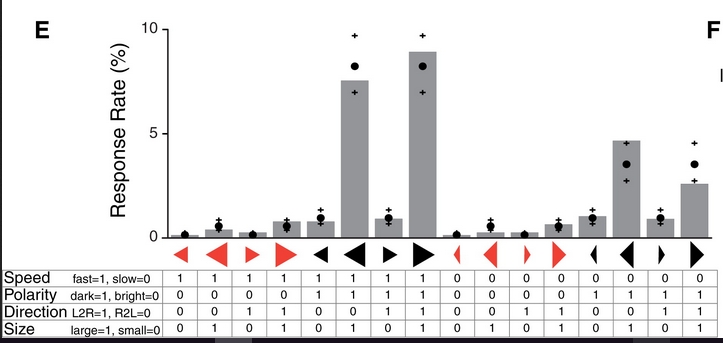| Fly Fishing Devon | Supplementary material | "Why does a trout take your fly?"
This page presents the results from several scientific papers to support the conclusion in the online article "Why does a trout take your fly?" "Zebrafish hunting responses are triggered by a combination of visual features. "Size, contrast polarity [dark or light] and speed of motion interact, such that stimuli that are large, dark, and fast are most effective in triggering hunting responses."
Source: Bianco,Isaac H. & Florian Engert. (2015) Visuomotor Transformations Underlying Hunting Behavior in Zebrafish, Current Biology, Volume 25, Issue 7, 2015, Pages 831-846, Available online
Figure 2 Section E. Hunting Responses Show Mixed Selectivity for Stimulus Feature Compounds
(E) Response rates for the 16 moving spot stimuli (236 events in 27 fish). Black spots indicate response rates predicted by the logistic regression model (crosses indicate 95% confidence interval [CI]). Symbols below the x axis indicate the features of each moving spot stimulus: leftward arrow, right-left; rightward arrow, left-right; large symbol, large; small symbol, small; elongated arrow, fast; short arrow, slow; red, bright; black, dark. The table indicates the binary coding scheme by which each stimulus is coded in terms of four feature values.
"The most effective stimuli were spots for which polarity was inverse (dark spots) and size was large. Fast-moving large, dark spots were also more effective than otherwise identical slow-moving stimuli. These results suggest that hunting responses are sensitive to multiple stimulus features." (Bianco & Engert. 2015)
" We conclude that larval zebrafish respond differentially to moving visual cues as a function of multiple stimulus features and are sensitive to the coincidence of particular feature values (feature compounds). Specifically, size, contrast polarity and speed of motion interact, such that stimuli that are large, dark, and fast are most effective in triggering hunting responses." (Bianco & Engert. 2015)
The authors discovered brain cells that responded to large, dark, moving spots - i.e. the most effective stimuli combination for eliciting hunting behaviour. "In conclusion, we find that tectal neurons show mixed selectivity and are sensitive to combinations of visual features (feature compounds). These include direction-selective cells with a preference for large, dark, moving spots that we found to be among the most effective stimuli in evoking hunting responses."
Figure 7. Model Circuit for Visual Prey Recognition and Release of Hunting Responses



